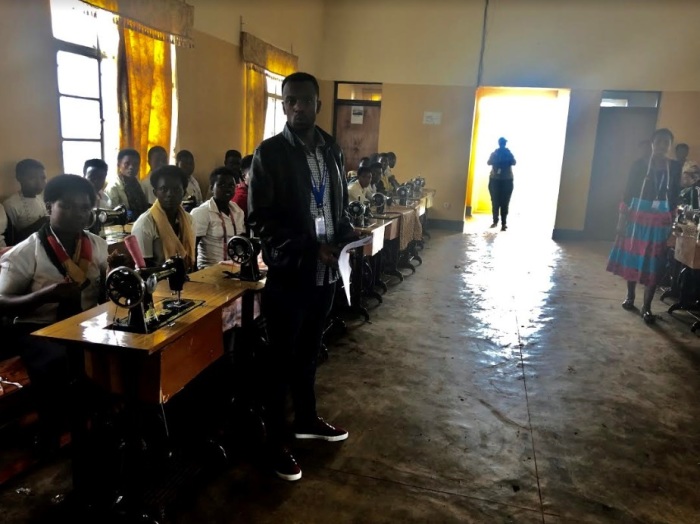Rwanda genocide 25 years later: How a Christian nation overcomes its troubling past
"Brick by brick"

World Vision is currently working on a five-year strategy that includes a facet of promoting “resilience and livelihood.”
For some Rwandans in extreme poverty, they have come to an acceptance of their life of dependence, not seeing an easy way to break free from that.
In the Western Province district of Nyamasheke, World Vision has empowered countless women by teaching them how to organize and run local community savings associations that grant women access to microloans that they can use to start their own businesses or money-making ventures.
With World Vision’s training, over 453 savings associations have been launched in the Nyamasheke district alone to help create enterprise for impoverished women villagers, according to Innocent Mutabazi, a World Vision Rwanda economic development specialist.
For some of these women, they were making as little as $0.70 per day farming on someone else’ property.
The savings groups consist of around 30 women each, usually neighbors. The women meet once each week and are able to save up their money by purchasing shares of the cooperative.
Through a partnership with a microfinance organization, loans can eventually be dispersed through the saving association. The members, who are given identification numbers, are allowed to borrow three times as many shares as the shares they have purchased. According to Mutabazi, the loans carry an interest of 5 percent.
Women can use the microloans to launch their own business endeavors and create greater economic stability for themselves and their families. The women must repay the loan within three months. Because of the interest generated by loans, the worth of shares increase.
Reporters met with women involved in one savings association in the Nyamasheke district, who said that the price of shares when the group first started was about 100 Rwandan francs. It has since risen to as high as 300 Rwandan francs per share.
The women are entitled to a share-out after about a year, where the amount generated in interest is shared among the association.
Participants in the women's savings association in the Nyamasheke district also give to a community social fund to help members in need during times of emergency. A February 2019 collection is shown in the video below.
“I used to live a very, very bad life. I was very very poor, the poorest of the poor,” 38-year-old Adissa explained through a translator, speaking her native Bantu language of Kinyarwanda. “But I thank World Vision for having brought us together and put us in groups. I wasn’t really proud of myself and how I [used to live] but that has changed.”
Adissa shared how she was made homeless after a large tree grew through the middle of her old house. She said that even in the rain, she had nowhere to cover herself. But with the help of the savings group, she was able to save up “brick by brick” until she was able to build a new home.
According to locals, mud bricks cost about 25 cents each. Adissa said that in total she needed 50,000 bricks to complete her house. She built the house step-by-step starting with the metal roofing. For years, she said, she lived in a home that was not fully complete.
“Through World Vision and the CORE Project and Dream financial institutions, with the loans that we acquired from there from our savings as a group, I was able to finish my house,” she explained. “So my children go to school. I eat well nowadays. I would like to thank World Vision for not just the house, I also have a few animals. I have got a small goat that is my own.”
Adissa said that she believes that she might soon be able to move out of Rwanda’s lowest wealth-grouping category into the second-lowest.
In Rwanda, all citizens are required to have healthcare but the poorest of the poor have the health care paid for them through the government. Now, Aidissa is confident that she will soon be able to pay for her own insurance.
Esther, 48, told reporters that because of the savings association, she was able to pay school fees for her children to go to school. She was also able to build a small house for herself that she is planning to turn into a shop.
“I have got five children. Before I joined this group, I was one of those people who would spend their days at home waiting for [my husband],” she admitted. “I would ask my husband for everything.”
Workforce development

In partnership with the Rwandan Workforce Development Authority, the Swedish International Development Corporation launched a three-year initiative called Creating Off-Farm Rwandan Enterprises (CORE Project) that aims to support youth and women-run off-farm income generating activities.
The CORE Project and the WDA, which was launched in 2008, support a number of vocational training centers designed to prepare youth and women for careers in areas such as tailoring, shoemaking, electricity, carpentry, and other manual labor-related fields.
The Nyamasheke district is an area that has been hit hard by unemployment. One training center in the district is called the “Youth Friendly Center,” which focuses on training local youth in hopes they can pursue those career paths or go off to more advanced training schools.
Although the teachers at the center are paid for by the Rwandan government, the center lacked the equipment to be able to run the school properly upon its founding in 2012.
At one time they had only five sewing machines for 25 students. But World Vision got involved in 2015 and donated 25 sewing machines, according to the center’s coordinator Jean Bosco.
As for classes in shoemaking, the center used to have just one machine for 10 students. But World Vision donated five machines. Today, they have six machines for 25 students.
World Vision also donated equipment for embroidery and hairdressing, as well as donating computers to help teach the youth how to be computer and internet proficient.
“We really appreciate the support of World Vision because we have been able to run the school properly,” Bosco said through a translator.
According to Fred Mubangizi, a World Vision Rwanda market facilitator, students are also taught business facilitation and training. Graduates of schools like the Youth Friendly Center often join cooperatives with other students to launch shops.
“Basically for those who are here, either they are in first or second categories of wealth,” Mubangizi explained. “The others may [come from large families and parents can’t afford to pay everything at home]. [Some] choose to join because they get a direct job from here rather than waiting [through the education process].”
“The important thing with them is giving them the training but not leaving them to go away and be scattered,” he added. “If you follow them and accompany them and give them business facilitation training — including financial literacy, cooperative management, business management — they go in that shop and they make good money as long as they are supported.”
The Youth Friendly Center has graduated 400 children since World Vision began its engagement with the school in 2015, Mubangizi told The Christian Post. But that center is not the only one aided by World Vision.
“We identify trades that can benefit people and we mobilize,” Mubangizi said. “We walk around the district and we motivate and mobilize the youth and women. After that, we work with the training centers, we provide key equipment to have hands-on practice.”
Follow Samuel Smith on Twitter: @IamSamSmith
or Facebook: SamuelSmithCP
















![[Ready to PUB] Christian psychologist: Kids must develop 'resilience' to fulfill God's purpose for them](https://cdn.christianpost.com/images/cache/thumbnail/25/92/259219_a_300_200_658_146.jpg)











